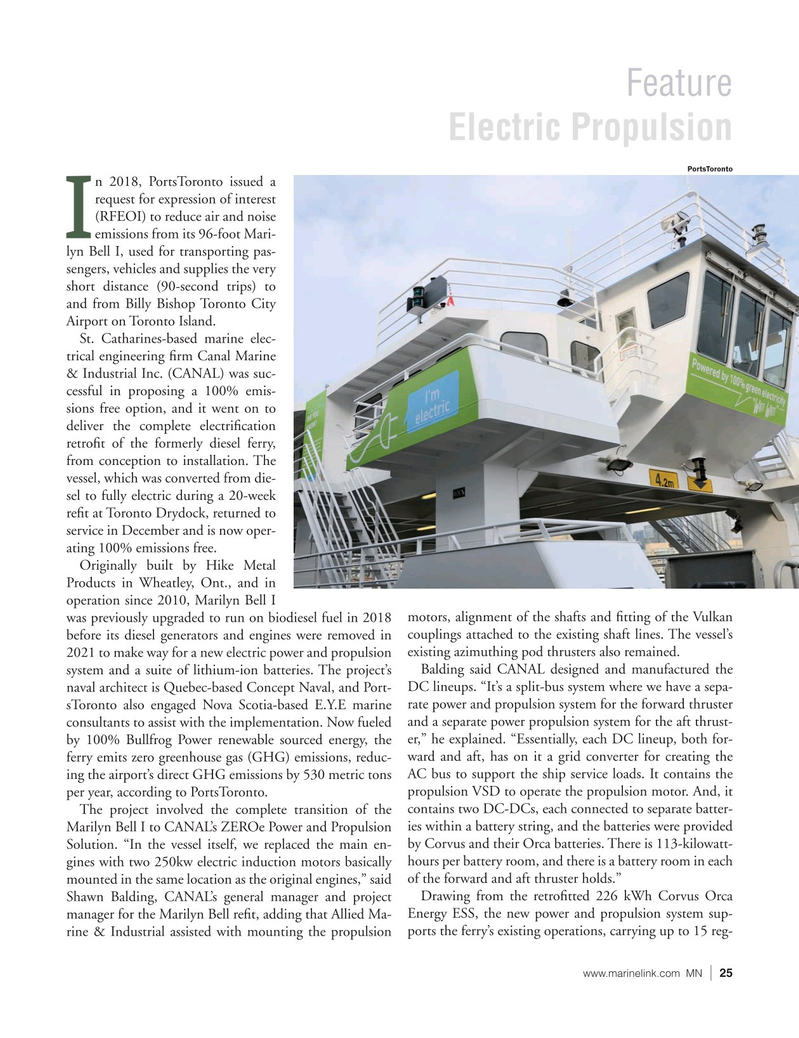
Page 25: of Marine News Magazine (January 2022)
Workboat Propulsion
Read this page in Pdf, Flash or Html5 edition of January 2022 Marine News Magazine
Feature
Electric Propulsion
PortsToronto n 2018, PortsToronto issued a request for expression of interest (RFEOI) to reduce air and noise emissions from its 96-foot Mari-
I lyn Bell I, used for transporting pas- sengers, vehicles and supplies the very short distance (90-second trips) to and from Billy Bishop Toronto City
Airport on Toronto Island.
St. Catharines-based marine elec- trical engineering ? rm Canal Marine & Industrial Inc. (CANAL) was suc- cessful in proposing a 100% emis- sions free option, and it went on to deliver the complete electri? cation retro? t of the formerly diesel ferry, from conception to installation. The vessel, which was converted from die- sel to fully electric during a 20-week re? t at Toronto Drydock, returned to service in December and is now oper- ating 100% emissions free.
Originally built by Hike Metal
Products in Wheatley, Ont., and in operation since 2010, Marilyn Bell I was previously upgraded to run on biodiesel fuel in 2018 motors, alignment of the shafts and ? tting of the Vulkan before its diesel generators and engines were removed in couplings attached to the existing shaft lines. The vessel’s 2021 to make way for a new electric power and propulsion existing azimuthing pod thrusters also remained. system and a suite of lithium-ion batteries. The project’s Balding said CANAL designed and manufactured the naval architect is Quebec-based Concept Naval, and Port- DC lineups. “It’s a split-bus system where we have a sepa- sToronto also engaged Nova Scotia-based E.Y.E marine rate power and propulsion system for the forward thruster consultants to assist with the implementation. Now fueled and a separate power propulsion system for the aft thrust- by 100% Bullfrog Power renewable sourced energy, the er,” he explained. “Essentially, each DC lineup, both for- ferry emits zero greenhouse gas (GHG) emissions, reduc- ward and aft, has on it a grid converter for creating the ing the airport’s direct GHG emissions by 530 metric tons AC bus to support the ship service loads. It contains the per year, according to PortsToronto. propulsion VSD to operate the propulsion motor. And, it
The project involved the complete transition of the contains two DC-DCs, each connected to separate batter-
Marilyn Bell I to CANAL’s ZEROe Power and Propulsion ies within a battery string, and the batteries were provided
Solution. “In the vessel itself, we replaced the main en- by Corvus and their Orca batteries. There is 113-kilowatt- gines with two 250kw electric induction motors basically hours per battery room, and there is a battery room in each mounted in the same location as the original engines,” said of the forward and aft thruster holds.”
Shawn Balding, CANAL’s general manager and project Drawing from the retro? tted 226 kWh Corvus Orca manager for the Marilyn Bell re? t, adding that Allied Ma- Energy ESS, the new power and propulsion system sup- rine & Industrial assisted with mounting the propulsion ports the ferry’s existing operations, carrying up to 15 reg- www.marinelink.com MN 25|

 24
24

 26
26
